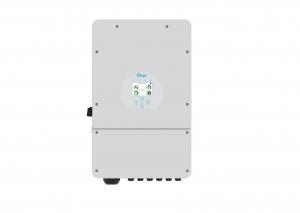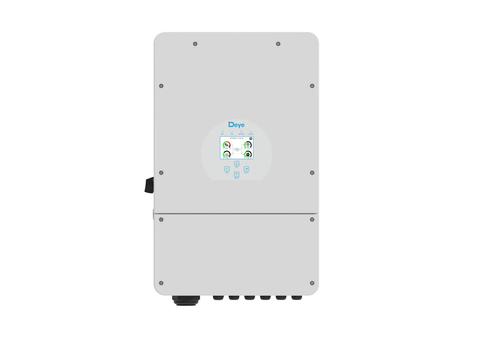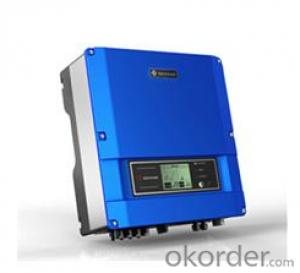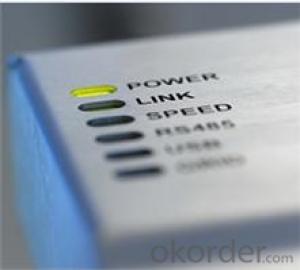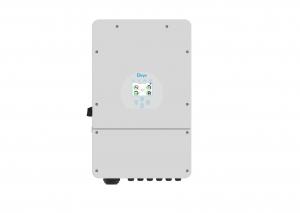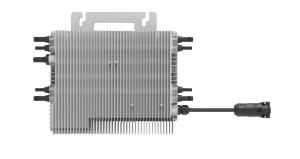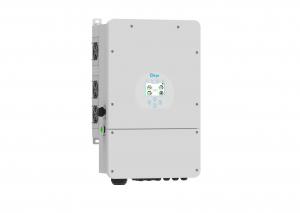SUN-10K-SG02LP2-US-AM3 deye inverters with US certificates from Panama's warehouse
- Loading Port:
- China main port
- Payment Terms:
- TT OR LC
- Min Order Qty:
- 50 pc
- Supply Capability:
- 5000 pc/month
OKorder Service Pledge
Quality Product, Order Online Tracking, Timely Delivery
OKorder Financial Service
Credit Rating, Credit Services, Credit Purchasing
You Might Also Like
Specification
Output Power:
13000
Inveter Efficiency:
97.6%
Output Voltage(V):
40-60V
Input Voltage(V):
370V
Output Current(A):
220
Output Frequency:
60/55-65
No. of MPP Trackers/ No. of Strings MPP Tracker:
3/2+2+2
Grid Connection Form:
2L+N+PE
Rated AC Input/Output Active Power (W):
10000
Specification:
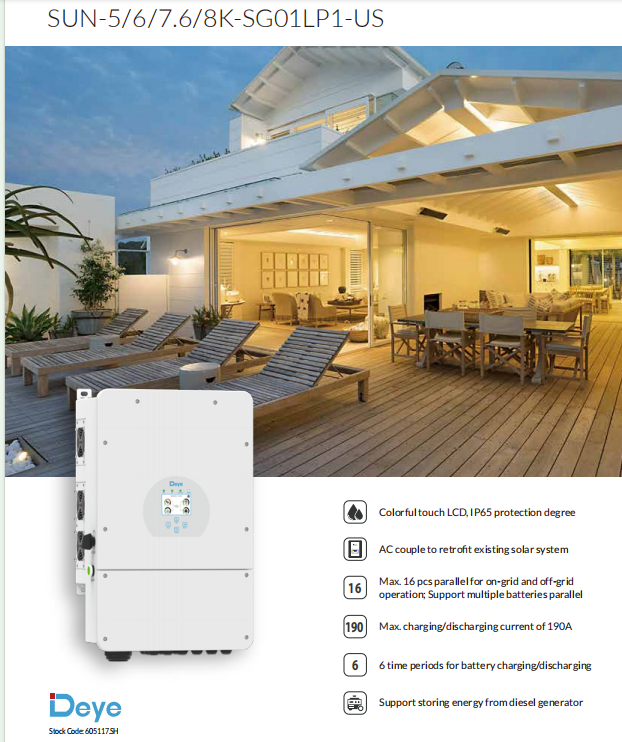
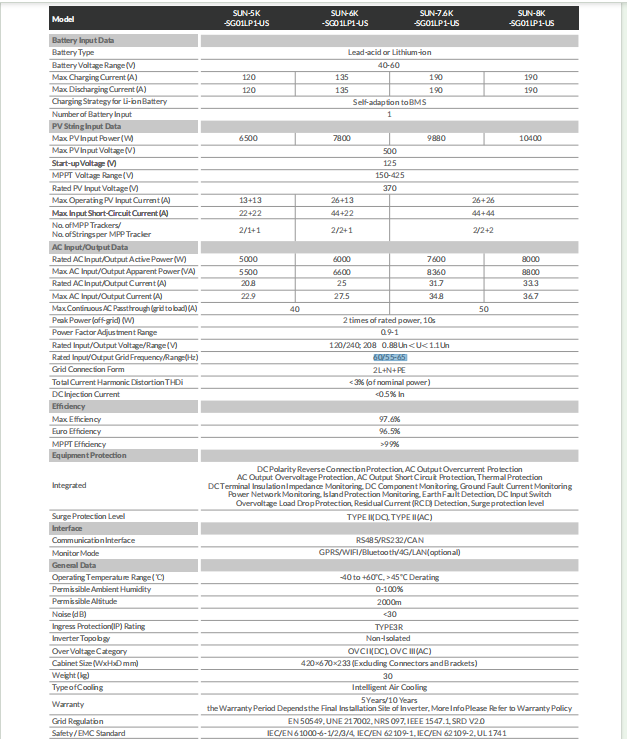
Application:

Company:

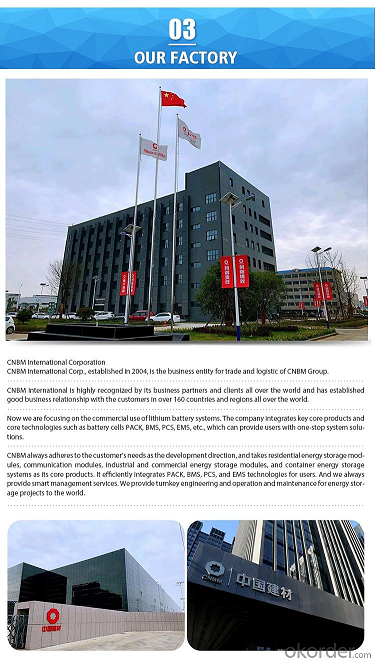

RFQ:
1.Are these products all from deye factory ?
Yes
2.Is this CNBM's Panama overseas warehouse
Yes
3.Are these goods from the bonded warehouse in Panama?
Yes
- Q: How does a solar inverter handle voltage and frequency variations caused by switching operations?
- A solar inverter is designed to handle voltage and frequency variations caused by switching operations through its built-in control mechanisms and advanced technology. When a solar inverter is connected to the grid, it monitors the voltage and frequency of the grid and adjusts its operation accordingly to maintain stability and safety. In the case of voltage variations caused by switching operations, a solar inverter typically employs a voltage control mechanism. This mechanism continuously monitors the voltage level of the grid and adjusts the output voltage of the inverter to match the grid voltage. If the grid voltage rises or falls beyond a certain threshold, the inverter automatically adjusts its output voltage to compensate and maintain a stable voltage level. Similarly, for frequency variations caused by switching operations, a solar inverter utilizes a frequency control mechanism. This mechanism constantly monitors the grid frequency and adjusts the inverter's output frequency to match the grid frequency. If the grid frequency deviates from the standard frequency, the inverter can quickly respond by adjusting its output frequency to maintain synchronization with the grid. To achieve this level of control, solar inverters often incorporate advanced digital signal processing algorithms and sophisticated control systems. These algorithms and control systems analyze the voltage and frequency signals from the grid, and based on predefined parameters, make rapid adjustments to the inverter's output to ensure compatibility with the grid. Ultimately, the goal of a solar inverter is to seamlessly integrate with the grid and provide a stable, reliable, and efficient power supply. By effectively handling voltage and frequency variations caused by switching operations, the inverter contributes to the overall stability and resilience of the grid, allowing for optimal utilization of solar energy and promoting a sustainable energy future.
- Q: What is the function of a solar inverter?
- The function of a solar inverter is to convert the direct current (DC) electricity generated by solar panels into alternating current (AC) electricity that can be used to power household appliances and feed into the electrical grid.
- Q: Can a solar inverter be used in a solar-powered desalination system?
- Yes, a solar inverter can be used in a solar-powered desalination system. A solar inverter is responsible for converting the direct current (DC) electricity produced by solar panels into alternating current (AC) electricity, which is required to power the desalination system. By utilizing a solar inverter, the solar energy generated can be efficiently utilized to operate the desalination process, making it a sustainable and environmentally friendly solution for producing fresh water from seawater.
- Q: How does a solar inverter handle voltage harmonics?
- A solar inverter handles voltage harmonics by incorporating filters and control algorithms that mitigate harmonics and ensure a smooth and stable output voltage.
- Q: Can a solar inverter be used with any type of solar panel?
- No, a solar inverter cannot be used with any type of solar panel. The compatibility between the solar inverter and solar panel depends on the type and specifications of both the inverter and the panel. It is important to ensure that the inverter is designed to work with the specific type and voltage of the solar panel to ensure optimal performance and efficiency.
- Q: What is the role of a solar inverter in grid management and stability?
- The role of a solar inverter in grid management and stability is to convert the direct current (DC) electricity generated by solar panels into alternating current (AC) electricity that can be fed into the grid. It ensures that the electricity generated by the solar panels is synchronized with the grid's frequency and voltage, thereby maintaining grid stability. Additionally, solar inverters can also provide grid management functionalities like reactive power control and voltage regulation, helping to balance and stabilize the overall grid system.
- Q: What is the role of a solar inverter in a solar panel system?
- The role of a solar inverter in a solar panel system is to convert the direct current (DC) electricity generated by the solar panels into alternating current (AC) electricity that can be used to power household appliances and be fed back into the electrical grid. It also ensures that the electricity produced by the solar panels is of the correct voltage and frequency for safe and efficient use in homes and businesses.
- Q: What is the role of a solar inverter in a solar-powered telecommunications system?
- The role of a solar inverter in a solar-powered telecommunications system is to convert the direct current (DC) generated by the solar panels into alternating current (AC) that can be used to power the telecommunications equipment. It is responsible for ensuring that the energy generated by the solar panels is compatible with the electrical requirements of the system, allowing for efficient and reliable operation of the telecommunications equipment.
- Q: Are there any safety risks associated with solar inverters?
- Yes, there can be safety risks associated with solar inverters. While solar inverters are generally considered safe, there are a few potential hazards to be aware of. These include electrical shock, fire hazards, and the release of toxic gases. It is important to ensure proper installation, regular maintenance, and adherence to safety guidelines to mitigate these risks.
- Q: What is the role of a solar inverter in a grid-independent system?
- The role of a solar inverter in a grid-independent system is to convert the direct current (DC) generated by the solar panels into alternating current (AC) that can be used to power household appliances and other electrical loads. It also manages the flow of electricity between the solar panels, batteries (if present), and the electrical loads, ensuring optimal energy utilization and system efficiency. Additionally, a solar inverter in a grid-independent system may incorporate advanced features like battery charging and discharging control, voltage regulation, and monitoring capabilities to ensure the stability and reliability of the system.
Send your message to us
SUN-10K-SG02LP2-US-AM3 deye inverters with US certificates from Panama's warehouse
- Loading Port:
- China main port
- Payment Terms:
- TT OR LC
- Min Order Qty:
- 50 pc
- Supply Capability:
- 5000 pc/month
OKorder Service Pledge
Quality Product, Order Online Tracking, Timely Delivery
OKorder Financial Service
Credit Rating, Credit Services, Credit Purchasing
Similar products
Hot products
Hot Searches
Related keywords
